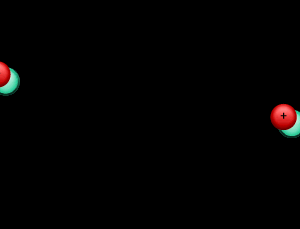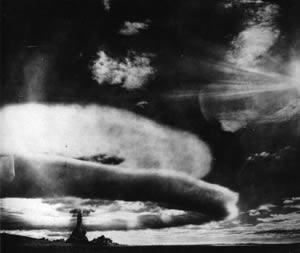However it is not that easy to fuse nuclei together the nuclei of deuterium and tritium, for example, have a positive charge and naturally repel each other when they come near. Electrostatic forces keep the two nuclei apart. A great deal of energy is needed to smash the two nuclei together with enough force to overcome the electrostatic force of repulsion.
Temperatures between 50,000,000 and 400,000,000 oC are needed. These can only be achieved by initiating a primary nuclear fission reaction.

Consider the simplified animation, on the right, of a thermonuclear weapon. A thermonuclear device contains two nuclear warheads. A primary warhead that contains the high explosives and a plutonium fuel and a secondary warhead containing the hydrogen isotope mixture. When the explosive detonates it compresses the plutonium fuel to a supercritical mass. At this point a runaway fission reaction occurs with the release of immense heat energy. This is the trigger for the fusion reaction that follows. One such weapon, known as the Tsar Bomba, was made by the Soviet Union and detonated in 1961.
The heat released from the fission reaction causes the fusion of hydrogen isotopes in the fuel mixture. The heat given off during fusion fuels the chain reaction.

The thermonuclear explosion creates enormous heat, powerful shock waves and deadly radiation in the form of gamma rays and neutrons that destroys living matter .
Up to this point nuclear fusion has seen uses in thermonuclear devices only. Nuclear fusion has proven very difficult to harness as a fuel source for power generation. However nuclear fusion represents a pollution-free alternative to current fission-based nuclear power technology. The product of nuclear fusion is the inert element helium rather than radioactive products as in nuclear fission reactions.
The day is getting closer when nuclear fusion will be the fuel of choice.

RDS-37, first Soviet hydrogen bomb
What prevents the hydrogen isotopes from fusing together at room temperature?
Why are temperatures in excess of 40,000,000 needed to fuse hydrogen nuclei together?
How are these temperatures generated in a thermonuclear weapon?
What is an isotope?
Why is fusion preffered as a fuel source over fission?
Where does the energy come from in both fusion and fission reactions?
What are gammar rays?
How do they damage living organisms?
Can gamma rays pollute the soil by making it radioactive?